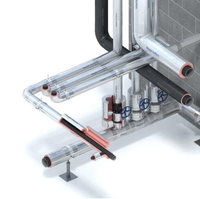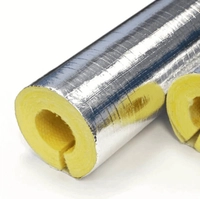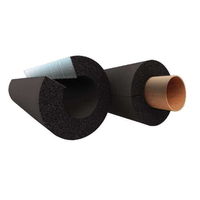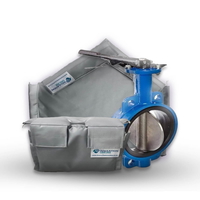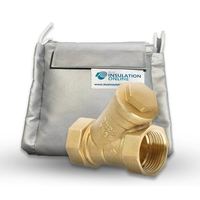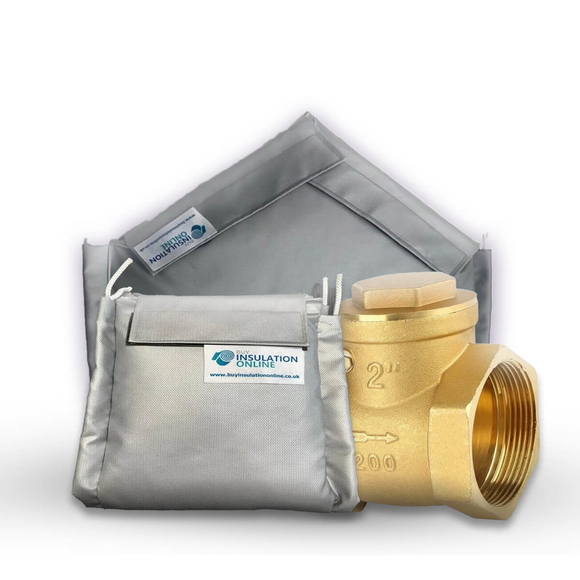
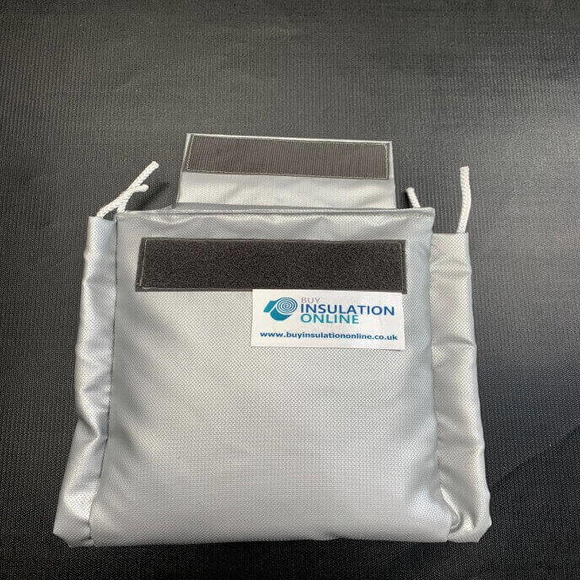
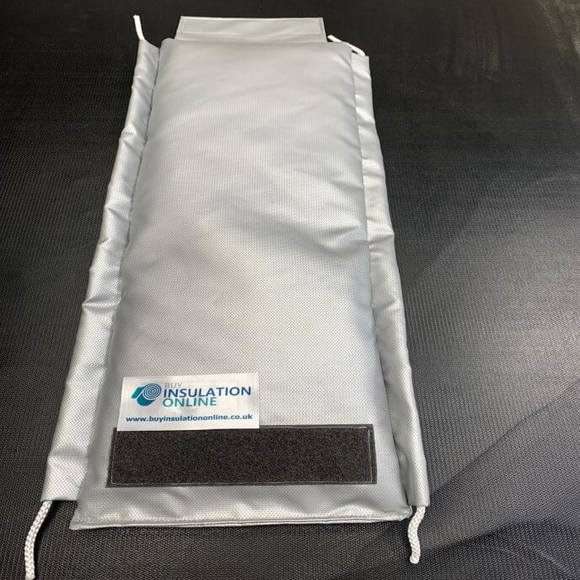
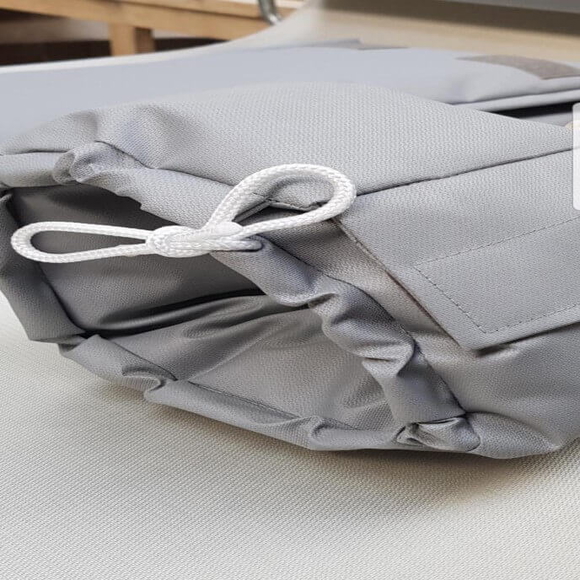
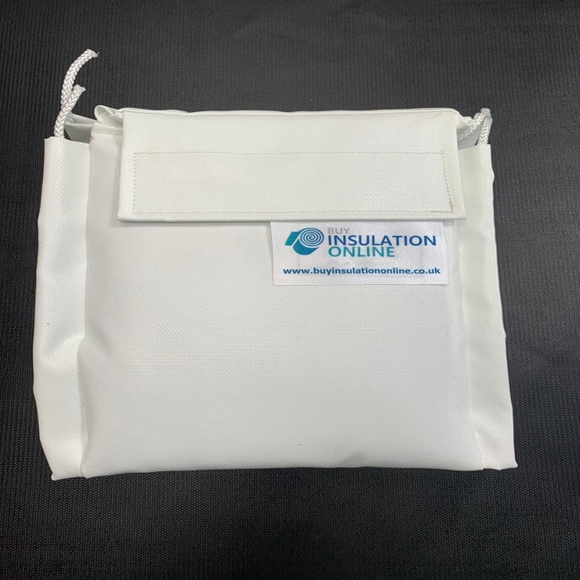
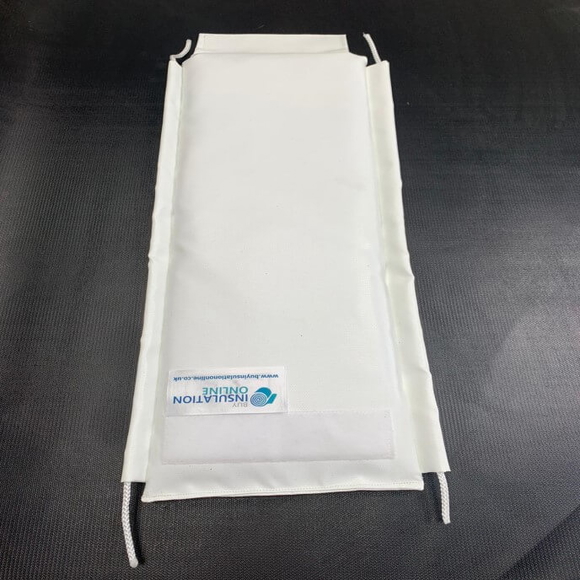
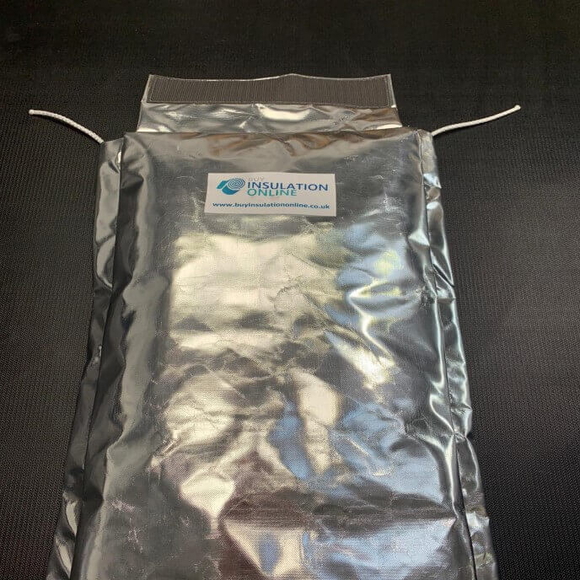







Check Or Non Return Valve Jacket Insulation
| Bulk Quantity Discount | |
|---|---|
| Minimum Quantity | Discounted Price |
| 5+ | 3% Off |
| 20+ | 5% Off |
| 40+ | 8% Off |
Request a Quote
Our team is happy to fulfil custom orders, offer special bulk discounts you cannot get from the website. Please get in touch today to discuss your needs.

Insulation jackets are perfect to insulate check valves, primarily because, they reduce heat loss whilst also protecting check valves from external damage. In our expert opinion, valve jackets are the perfect insulation solution to check valves, here’s why:
Easy to install and Maintain: Unlike the rigid insulation that was previously used to insulate check valves, valve jackets are flexible and easy to use. They have velcro straps and pull cords that ensure superior insulation even around the awkward angles of the non-return valves. They can be just as easily reapplied without any damage to the check valves or loss of insulation.
Thermal Insulation: Thermal insulation jackets contain 50mm Rockwool insulation. Mineral wool with low thermal conductivity helps reduce heat loss in check valves. They give superior insulation around the check valves thereby saving both energy and money. Valve covers are particularly helpful in commercial and industrial environments.
Safer Workplace: Valve jacket insulation is made with high-quality silicone-coated glass cloth for both outdoor and indoor applications. The valve covers that we make not only ensure a smooth and neat finish but also help protect personnel from direct contact with hot surfaces. They help reduce cases of accidents leading to burns in workplaces. Since valve jackets provide superior thermal insulation to the valves, it helps reduce condensation and sweating in check valves. This, in turn, minimises instances of small pools of water being formed due to condensation eventually leading to slips or accidents in the workplace.
Product Specification:
- Product Sizes: 15mm, 20mm, 25mm, 32mm, 40mm, 50mm, 65mm, 77mm, 100mm, 125mm, 150mm, 200mm, 250mm and 300mm.
- Colours: Standard grey, silver and black.
- Type:
- External jackets: External valve jackets have a waterproof PVC layer on the outside whilst their inner side is made of silicone glass cloth
- Internal jackets: Internal valve jackets are made of silicone glass cloth on both sides.
Key Features:
- Valve covers are the perfect, flexible and lightweight insulation solution for check valves.
- Easy to use, handle and install.
- Cost-effective and convenient valve jackets reduce energy bills.
- Airtight fitting ensured with velcro flaps and pull cords.
- Designs to perfectly fit the check valves.
- Improves workplace safety.
Applications:
- Designed to closely fit around check union valves to maximise insulation and prevent heat loss.
Product Details:
- Service Temperature: -20ºC to 220ºC
- Insulation: 50mm Rockwool
- Cloth: Silicone glass cloth / PVC
Note:
- All Valve jackets are made to order, No returns, refunds or exchanges will be applicable. If you are unsure of the size, please email us a picture of the valve and its dimensions for our experts to access and make the valve covers suitable for your application. We will assist you in any way we can.
- Lead times for check valve covers within the UK: 1-10 units: 5-7 working days, Anything above that, please email us for the lead times.
- We manufacture valve covers for check valves in sizes ranging from ½ an inch to about 12 inches.
- They are also available in silver, standard grey and standard black colours.
- Insulation jackets are cost-effective and help reduce heat loss in check valves.
- Valve jackets function perfectly in temperatures between -20°C to 220°C
- They protect personnel from coming in direct contact with hot valve surfaces, thereby valves, making the workplace safer.
- Valve covers help improve the service life of check valves.
- They can be easily installed and maintained.
- All valve jackets are made to order and NON REFUNDABLE
| Insulation Type | Valve Covers |
| Cloth Material | Silicone glass cloth / PVC |
| Insulation | Mineral Wool |
| Suitable for | Check valves and non-return valves |
| Colours Available | Standard Black, Silver and Standard Grey |
| Standard Sizes |
15mm, 20mm, 25mm, 32mm, 40mm, 50mm, 65mm, 77mm, 100mm, 125mm, 150mm, 200mm, 250mm and 300mm |
| Service Temperature |
-20 °C to +220 °C |
| Delivery Terms | |
|---|---|
| Order Value (Excluding VAT) | Delivery Charge (Excluding VAT) |
| Above £390 | Free delivery |
| Up to £390 | £15 |
Product: All valve covers are made to order and NON-REFUNDABLE. If you are unsure of the size, please email us a picture of the valve and its dimensions for our experts to access and make the valve covers suitable for your application. We will assist you in any way we can.
We welcome you to share information on the pipe insulation thickness and images of your application along with the order to help us get your requirement correctly.
If you require a quote for these valve jackets, please do email us with your requirements
Lead time: Quantities 1-10 are about 5-7 working days. For anything above please email us for the lead times.
Returns and cancellations:
You are free to cancel your order before we confirm your order via email. Once an order confirmation email is sent, cancellations, returns and refunds will not be acceptable.
Additional information:
- We do site surveys and supply valve covers or we can only survey your premises. If you would like a site survey, kindly email us your site address or fill the contact form above.
- The prices for the chilled/cold water valve jackets may differ from the ones displayed on the website. Chilled/cold water valves usually need to be wrapped with a vapour barrier, which would increase the jacket size and cost. If you need chilled/cold water valve covers, please mail us your requirements and we will send you a quote for your order.
- We also make valve covers in red, blue and green colours. If you have any such requirements, please get in touch with us.
Customer Reviews
“ This jacket was delivered to the jobsite on time. I loved the product quality and its functioning we...”Darius
“ Cost effective and highly functional jackets in order to protect your check valves. Highly functiona...”Philip
“ Thermal insulation jackets contain Rockwool insulation with low thermal conductivity. It helps redu...”Fletcher
“ If you are looking for something that will protect your check valves thoroughly. Then my friend your...”Denis
“ They are very easy to install and maintain as well. Unlike the rigid insulation that was used tradit...”Ziggy
“ The delivery was quick and before time. The product was packed safely as well. The quality is superi...”Ernie
“ These insulation jackets are ideal and perfect to insulate check valves. fits the dimension perfectl...”Colby
“ They are very easy to install. Totally worth the cost”Cian
“ There are number of options available in the market and online platform as well, for this function a...”Arjun
“ The valve covers fit the valves just perfectly. had ordered a standard grey valve cover. good produc...”Reign
“ Fits as expected. delivered on time, no complaints”Benjamin T.
Our Customers Include








When it comes to valve insulation, opting for non-return valve jacket insulation provides advantages such as enhanced energy efficiency and prolonged equipment lifespan. This aids in preserving optimal temperatures and protecting your equipment. It is important to routinely check these jackets for any signs of damage. Proper fitting and secure attachment are crucial for effective operation. By comprehending the benefits and materials utilised in valve jackets, you can make informed choices regarding the efficient maintenance of your equipment. Recognising the significance of insulation jackets for valves is essential for safeguarding your equipment and ensuring its durability. Further insights on the benefits of valve insulation are available.
Key Points
- Non-return valve insulation improves energy efficiency.
- Regularly inspect valve jackets for signs of damage.
- Ensure a correct fit for efficient insulation.
- Various materials provide different levels of insulation.
- Insulation jackets safeguard valves and help to regulate temperatures.
Valve Insulation Jackets Overview
Valve insulation jackets offer efficient thermal protection, worker safety, and streamlined maintenance for a variety of valve types and sizes. When it comes to maintenance tips, regularly inspecting the insulation jackets for any signs of wear and tear is essential. By addressing any issues promptly, you can prevent heat loss, guarantee peak performance, and extend the lifespan of your valves. Additionally, proper installation and secure fastening of the jackets are vital to maximise their effectiveness and durability.
In terms of cost efficiency, investing in valve insulation jackets can lead to significant long-term savings. These jackets help conserve energy by minimising heat loss, reducing the need for constant heating, and ultimately lowering your utility bills. Moreover, the durable materials used in these jackets provide excellent protection against corrosion and external damage, reducing the frequency of repairs and replacements. By choosing the right valve insulation jackets and following maintenance best practices, you can enjoy improved efficiency and cost savings in the long run.
Advantages of Non-Return Valve Insulation
To maintain peak performance and extend the lifespan of your valves, considering the benefits of insulating non-return valves is a strategic step towards enhancing energy efficiency and equipment longevity. When you insulate your non-return valves, you can experience the following benefits:
- Energy Efficiency: Insulating your non-return valves helps prevent heat loss, guaranteeing that your system operates at peak levels, reducing energy waste and lowering utility costs.
- Equipment Protection: By insulating these valves, you provide a protective barrier against freezing temperatures, safeguarding your equipment from potential damage and increasing its durability.
- Stress Reduction: Insulation promotes even stress distribution within the valves, reducing the risk of failure and prolonging the overall lifespan of the equipment.
- Optimal Temperatures: Maintaining consistent temperatures through insulation ensures that your system operates efficiently, preventing heat loss and maintaining the ideal conditions for performance.
Materials Used in Valve Jackets
Valve jackets can be made from a range of materials including fiberglass, silicone-coated fiberglass, PTFE, and ceramic fiber.
Each material has unique characteristics such as insulation levels, durability, and resistance to high temperatures.
Fiberglass is commonly used for general insulation, PTFE provides chemical resistance, and ceramic fiber is excellent for high-temperature applications.
Insulation Types for Valves
When selecting insulation for valve jackets, various materials such as fibreglass, mineral wool, foam, and aerogel are commonly used to provide different levels of thermal protection. Each material has its unique benefits for insulating valves, catering to different needs and preferences:
- Fibreglass: Offers cost-effective thermal efficiency and is lightweight, providing good insulation for valve applications.
- Mineral Wool: Provides excellent fire resistance and acoustic insulation, ensuring temperature control in industrial valve settings.
- Foam: Versatile and easy to install, foam insulation covers offer effective thermal protection for valves in diverse conditions.
- Aerogel: Known for superior thermal performance, lightweight design, and thin profile, ideal for efficiently insulating valves in demanding environments.
These materials play an important role in maintaining energy savings and optimising the performance of insulated valves.
Advantages of wearing a jacket
Jacketing materials used in valve jackets provide essential thermal insulation properties important for protecting valves and preventing heat loss. These materials, such as fibreglass, silicone-coated fibreglass, PTFE, and high-temperature fabrics, contribute significantly to energy efficiency and cost savings by regulating temperatures effectively.
Fibreglass jackets, known for durability and flexibility, are commonly used due to their resistance to high temperatures. Silicone-coated fibreglass jackets offer added protection against moisture, chemicals, and abrasion, enhancing environmental protection. High-temperature fabrics like ceramic fibre excel at providing superior insulation for valves operating in extreme heat environments.
Choosing the right jacketing material for your valves can lead to increased efficiency, reduced energy costs, and better environmental stewardship.
Installation Process Requirements
To properly insulate your valves, ensure you choose suitable insulation materials like fiberglass, mineral wool, or aerogel for your valve jackets. When considering the requirements for installing valve jackets, remember the following:
- Opt for insulation techniques that maximise thermal efficiency to ensure top performance.
- Pick durable outer covers such as silicone-coated fiberglass or PVC for longevity in challenging environments.
- Use secure fastening materials like Velcro straps, buckles, or drawstrings to effectively keep the jacket in place.
- Seek out extra features like grommets or windows that enhance accessibility and maintenance ease while retaining insulation properties.
Ordering and Measuring Valve Jackets
To ensure a proper fit for your valve jacket, it is crucial to measure the valve diameter accurately. By precisely determining the valve circumference and length, you can ensure that the insulation cover fits snugly. This essential sizing is vital for effective insulation and energy efficiency. Here are some measuring techniques to help you order the correct valve jacket size:
|
Measurement |
Technique |
Importance |
|
Valve Diameter |
Measure the widest part of the valve horizontally |
Ensures the jacket covers the valve properly |
|
Circumference |
Wrap a measuring tape around the valve |
Helps determine the size of the insulation cover needed |
|
Length |
Measure the vertical dimension of the valve |
Ensures the jacket covers the entire length of the valve |
Installation Guide for Valve Jackets
Are you looking to ensure a proper fit for your valve jacket while optimizing thermal insulation and worker protection in industrial settings? When fitting valve jackets, follow these steps to ensure safety, efficiency, and peace of mind:
- Proper Fitting: Measure your valve carefully to select the correct jacket size for a snug fit that minimises heat loss and maximises insulation efficiency.
- Secure Installation: Use fasteners to securely attach the jacket in place, ensuring it remains in position during operation and maintenance tasks.
- Regular Maintenance: Carry out periodic checks to identify any gaps, loose areas, or signs of wear that could affect the jacket's performance over time.
- Safety First: Prioritise worker safety by ensuring the jacket is correctly installed to provide protection against potential burns or accidents in industrial environments.
Applications of Valve Insulation Covers
Valve insulation covers play an important role in enhancing temperature control and safety across various industrial sectors. These covers are not only essential for maintaining thermal efficiency but also for reducing noise levels in industrial settings. Here is a table summarising the applications of valve insulation covers:
|
Applications |
Benefits |
|
Cryogenic facilities |
Thermal efficiency, protection from heat loss and corrosion |
|
Petrochemical plants |
Safety, passive fire protection, insulation for equipment |
|
Turbines |
Noise reduction, specialised protection in hazardous environments |
|
HVAC systems |
Energy consumption reduction, thermal and acoustic insulation |
|
Industrial settings |
Extending equipment lifespan, preventing external damage |
Commonly Asked Questions
How do I choose an insulated jacket?
When choosing an insulated jacket, consider insulation types and features that match your needs. Choose the right thickness for benefits such as energy efficiency. Ensure compatibility and material suitability for a secure and effective fit.
How do I know if my jacket is insulated?
To determine if your jacket has insulation, check for how well it retains heat or feels cold. Check the label for information on the thickness and materials of the insulation. Thicker, warmer jackets are probably insulated. For more specific information, contact the manufacturer or supplier.
What is the difference between a jacket and insulation?
Essentially, jackets are the protective covering, like metal or fabric, while insulation, like foam or fiberglass, is the heat-trapping material inside. Jackets shield and add flair, insulation keeps things cozy.
What does 80G insulation mean?
When it comes to 80g insulation, think of it as a cosy shield against the cold. It's like wrapping yourself in a warm hug, understanding thermal resistance, and layering for warmth in chilly conditions.
Summary
In summary, insulating your non-return valve with a jacket can provide numerous benefits, such as energy savings and preventing heat loss.
By using high-quality materials and following proper installation procedures, you can guarantee top performance and longevity of your valve.
Whether it's for industrial or residential applications, valve insulation covers play an essential role in maintaining efficiency and reducing costs.
Consider investing in a valve jacket to improve the functionality and efficiency of your system.
